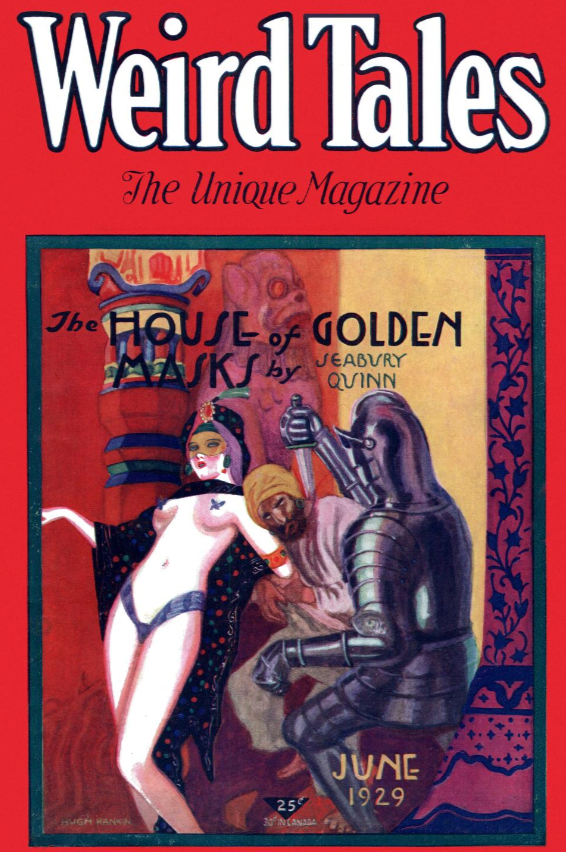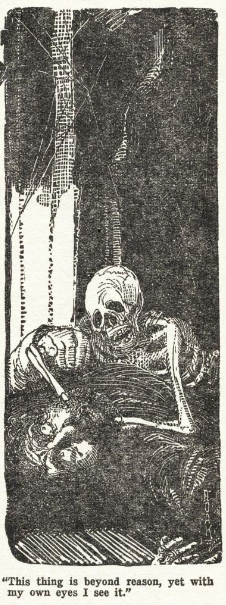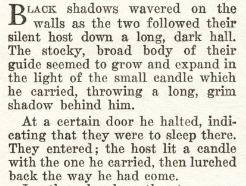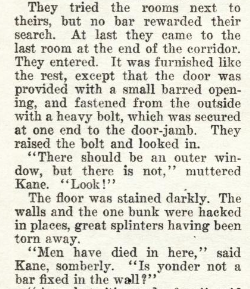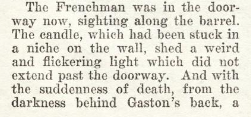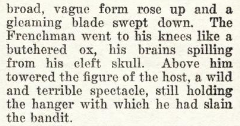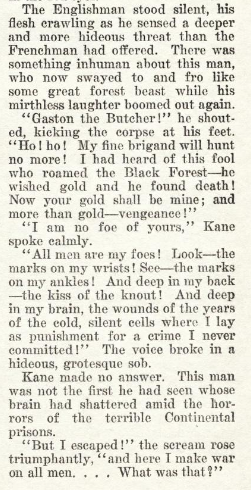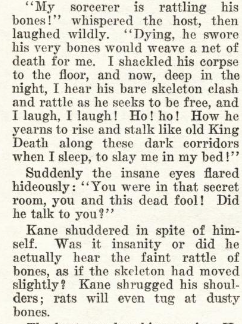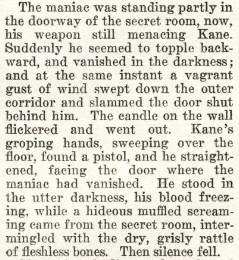Like a true Barbarian Hero I am currently adventuring in distant lands, having braved the cursed tomb of Newark Airport to arrive in the bleak, windswept hills of Pennsylvania, where death and danger lurk in the shadows of every tree, mountain, and Wawa. But that doesn’t mean an end to my long-as-hell ramblings, no, far from it indeed! For hark! Another edition of Pulp Strainer (Sword & Sorcery Edition) is upon us, and we’re continuing our REH lovefest with probably my favorite Conan story of all time: The Tower of the Elephant from the March 1933 issue of Weird Tales!
“The Tower of the Elephant” is an interesting story because, aside from being rad as hell, it was also the first Conan story where he’s an adventurer, wandering through civilized lands in search of fortune and excitement. The previous two stories published in Weird Tales, “The Phoenix and the Sword” (Dec ’32) and and “The Scarlet Citadel” (Jan ’33) both take place when Conan is wearing the crown of Aquilonia upon his troubled brow (my least favorite phase of Conan’s chronology, personally). Interestingly, the first tranche of three stories that REH submitted to Weird Tales included “The Frost Giant’s Daughter” which had Conan as a young wanderer up among the viking-flavored berserkers of Hyboria; it was rejected by Farnsworth Wright, however, and wouldn’t be published until the 70s, if I recall correctly. “The Phoenix and the Sword” story is a reworking of an unsubmitted Kull story anyway, swapping out Kull for Conan and expanding the evil sorcerer Thoth-Amon a bit, but still it’s mostly concerned with Conan’s tenuous hold on the throne as a barbarian usurper. “Scarlet Citadel” is a similar (but better) story, this time with King Conan betrayed and imprisoned (in a legitimately cool-as-hell dungeon full of awesome monsters) while his kingdom totters.
Both are fun and all, and they certainly have good sword-and-sorcery action, but for my money Conan is at his most interesting when he’s just a rogue and a reaver, a barbarian wandering among “civilized” people, relying on his wits and his strength to survive. According to some histories I’ve read, following the positive response to the first two Conan stories, Wright encouraged Howard to work up an essay on the world of “Hyboria” that he’d created and glancingly mentioned; the result of that work would be important for Howard, who got interested in exploring more of these lands in greater detail, leading him to write “The Tower of the Elephant,” a very different sort of Conan story from those he’d written previously.
But, as always, before we can get into that let’s take a look at the cover! And damn if it ain’t a spicy one this time!

That’s a Brundage, of course, still obscuring her gender behind the semi-pseudonym of “M. Brundage.” Just a straight-up buck-ass naked lady hanging out her wolf pack, what’s it to ya buddy, huh? You some kinda prude or something!? The story is a perfectly serviceable Jules de Grandin adventure from ol’ Quinn, this time with some interesting werewolfery thrown in. As for the ToC, there’s some interesting stuff here too:
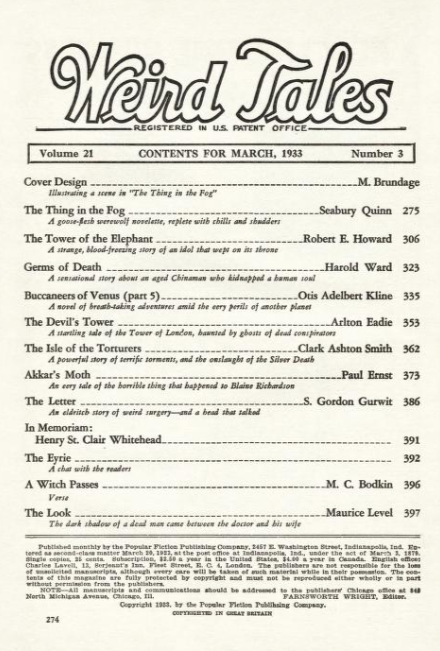
Kline, Smith and Ernst here too, all solid fellows, but the interesting thing here (besides from our Conan story) is the “In Memoriam” for Henry Whitehead. Whitehead is an interesting guy, an Episcopalian minister who lived and worked for most of his life in the Virgin Islands (specially St. Croix) and used that setting and island folklore for his weird fiction. He was a good friend of Lovecraft, who actually visited Whitehead in Florida after he’d retired and spent several weeks with him and his family; it’s actually HPL who wrote the “In Memoriam” here, and the affection he felt for his friend is evident, I think. Whitehead is also interesting from a horror perspective because he’s basically the guy who introduced a lot of what would become the dominant pop cultural understanding of “Voodoo” into weird literature. An interesting and important figure, though little known these days.
But enough of that, there’re Towers to be scaled, Threats to be overcome, and Fabled Gems to be plundered! Let’s get into it!

A neat title illustration to this one, by ol’ Jayem Wilcox again. As is usual in Weird Tales, this illustration is based on a scene near the climax of story; it’s a bad habit of theirs and has in the past given away too much of the story, but here it’s okay since the way the story unfolds is a bit more complex than what is shown here. But, regardless, it’s fun to see the way the artists were envisioning Conan at a time when the visual iconography hadn’t been invented yet for sword and sorcery; we’re so used to Frank Frazetta’s iconic paintings from the 70s that these early Conans can be a bit jarring. They always remind me of Douglas Fairbanks, more like a dashingly handsome swashbuckler than the dark and brooding barbarian we’re used to. In particular, the vaguely Celto-roman tunic thing is an interesting touch, especially since Conan is explicitly described as being stripped to the loin cloth for much of this story.
Like I mentioned up top, REH wrote this story hot on the heels of a personal history/geography of his secondary world, something that really comes through in the beginning of this story, I think:
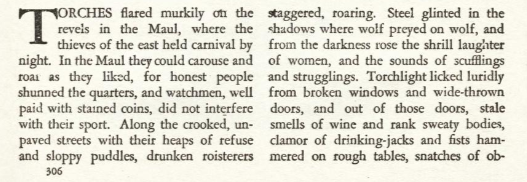
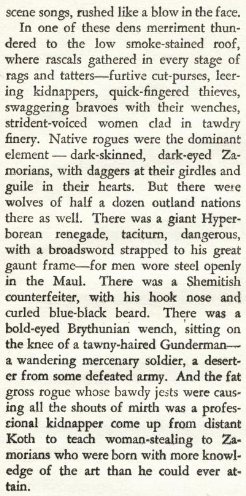
I mean, c’mon; that’s just some incredible sword-n-sorc stuff, right? A thieves’ quarter called The Maul where all the rough bastards and real assholes like to party, a real grim and grimy scene; the sensory language is so rich here, and the combination of visual (torches flaring, steel glinting), auditory (roaring thieves, shrill laughter, scufflings and strugglings, fists-hammering), tactile (sloppy puddles), and especially olfactory (heaped refuse, stale wine and “rank sweaty bodies”) descriptors perfectly evoke a rough neighborhood on a Saturday night in a fantasy city. And all in a single introductory paragraph! There’s a danger of reading REH and thinking he’s cliche, but that’s simply because he invented the things that would later become cliche in the hands of lesser writers, but even so, I think everyone can appreciate the sweep and power of his writing. This is simply good sword and sorcery writing.
The second paragraph seems born from the supplementary writing that REH had been doing. He’s obviously been thinking a lot about the geography and history of his secondary world, inspired by Farnsworth Wright to elaborate and develop some coherency for his fantasy setting. Now Howard never got into the depths of codification than Tolkien did; that’s a good thing in my opinion, since he had neither the expertise nor the time that Tolkien did to do a job of that size. Also, honestly, I think Howard’s rough-sketch or thumbnailed approach is actually much richer and more productive than the strict and set-in-stone “series bible” that a lot of later fantasy writers use. I mean, Howard apparently never even made a map until some fans wrote and asked for one, and I think that kind of hazy uncertainty, in addition to having much more verisimilitude, also gives a lot more freedom to the writer. Howard could slap Conan into a high seas galleons-and-pirates adventure one story and then drop him into a ziggurat full of demon-worshipers the next, and that’s important to the freshness of a series of short stories helmed by the same character. Maybe a novel requires more secondary world discipline, although if so I’d say that’s yet another point in favor of my “short story is the superior prose format” argument.
The other thing that strikes you immediately in that second paragraph is the very obvious racial/ethnonationalist reductionism that Howard uses. The Zamorans are all dark and guileful, there’s a very uncomfortably described Shemitish counterfiter, there’re tawny-headed Gundermen, etc. It is important to acknowledge that Howard was 100% a dyed-in-the-wool and absolutely committed racist, and that it played a huge part in his writing and his world view. A lot has been made of Howard’s love of the barbarian and his belief, quite sincerely, that civilization was largely an accidental configuration of society, fragile and unstable and always temporary, and that the natural state of humanity was the noble savage. Civilization poisons the individual, makes them soft and sneaky and duplicitous and decadent, and part of that decadence for Howard is the mingling of races, both socially and, horror of horrors for a white southerner like him, reproductively.
Equally important for Howard is his belief in a Spencerian hierarchy of the races, meaning that all barbarians are not created equally. The Cimmerians, Conan’s people, represent the highest and best of the barbarians – white, rough, hardy, savage but with an inborn sense of fair-play and nobility about them. Next down the hierarchy for Howard are the Picts who, in the Conan stories, are basically an early 20th century pop cultural expression of the Native Americans, almost as good as a white barbarian but given over to superstition and cruelty. It is notable that Howard never introduced a black barbarian, and even in the stories where Conan is running around the fantastical precursor of modern Africa, the northern barbarian’s woodcraft, survival skills, and martial prowess always trump the natives, even in the depths of their own home territories. As an aside, let me pause here to plug the late Charles Saunder’s “Imaro” and “Dossouye” series of books, truly great sword-and-sorcery by a black writer who loved the genre and also thought deeply and insightfully about its history, politics, and shortcomings.
But it’s important to recognize that this racism is a big part of Howard’s writing, and it will not be going away – it is integral to how he envisions the world and creates his stories, even more so than in the works of his friend and fellow racist, Lovecraft. And here, where Howard has begun to really think about the world of Conan, those beliefs and prejudices are getting baked into Hyboria.
But anyway, let us continue. Our synoptic view of The Maul narrows down to a specific corner of a specific bar, where a Kothic slaver is giggling sloppily about the Brythunian girl he’s going to kidnap and sell into sexual slavery in Ophir – grim stuff!


And it is this mention of the Elephant Tower that causes the ears of a tall barbarian youth to perk up…
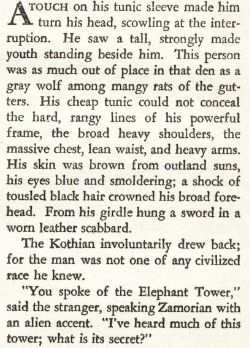
That’s our boy for sure, but this is a much different Conan than the readers’ of Weird Tales were used to. The previous stories had centered on Conan the King, a middle aged, experienced, and supremely confident ruler and warrior king. This is a youth, seemingly fresh from Cimmeria and perhaps experiencing for the first time the decadent and dangerous cities of the south. I think this is also the only time Conan is described as having an accent, a signifier of both his inexperience and his barbaric foreignness.
ALSO I might as well point out here the loving and expressive attention paid to Conan’s body, a hallmark of Howard’s sword-and-sorcery in particular. Howard’s interest in masculinity and the body is clear in all his work, but with Conan in particular it’s an important part of the stories. For one thing, diegetically it’s the key to how he makes his living; Conan as warrior, thief, and survivor relies on his body above all else, and its stamina, its strength, and its smooth and powerful functioning are all central to his adventures. Secondly, it’s a signifier of his barbarity; his body is hard and lean and disciplined from his life and background; his strength is inherent and native to his body, which is very different from the civilized people in the stories, who are either soft and weak from easy living or who, it is implied, must train and work and practice to attain physical fitness in spite of their surroundings. This is a key difference, because again, for Conan, his strength, his muscular coordination, and his reflexes are all natural, honed from the life-or-death struggle that is a barbarian’s lot. No amount of training or expertise or practice can ever match it, because even the most diligent body-builder or swordsman or thief is, at core, artificially attempting to mimic what is pure and natural to the barbarian. Finally, it’s worth pointing out the homoeroticism inherent here. I’ve never done it, but an analysis of Howard’s use of superlatives and adjectives to describe specific characters would be extremely telling; even in stories with women characters, dollars to donuts Howard lavishes at least twice as much ink on Conan’s broad hairy chest and mighty thews as on heaving bosoms and curvaceous hips. I’m not saying Howard was gay, but I am saying that it is clear from the stories that what he is interested in is masculinity, pure and simple, it’s perceived strength and ruggedness and the way it’s expressed in the idealized masculine form.
Lotta damn theorizin’ and philosphizin’ there, sorry! Let’s get back to the damn story!
This young barbarian, still unintroduced formally, has heard this the man’s strange statement, and wants to know what is the secret of the Elephant Tower? The Kothic slaver, well in his cups and enjoying the role of an in-the-know city slicker, decides to set this rube from the sticks straight.


Heedless of his danger, our Kothic drunkard gets on his high horse and deigns to explain to this Cimmerian hick that Zamora is the City of Thieves, and if someone could have stolen the Heart of the Elephant then it would already have been done. But Yara the Priest, whose magic is unparalleled, guards his prize with both steel and dangerous sorcery. But what of climbing the tower and coming in from above, asks the Cimmerian?

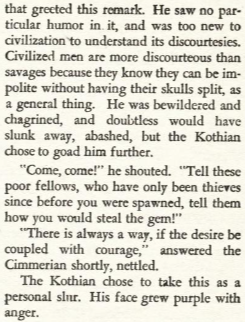
The threat of a fight sends the crowd surging backwards, and the single candle illuminating the scene is snuffed out. Chaos erupts, there’s shouting and screaming and a single strident yell…and when the candle is relit the barbarian is gone and the Kothic slaver lies dead, ripped open by a sword stroke unerringly delivered in the dark.
I’ve spent a LOT of time on this first section because I think it warrants it. First of all, it’s just great, thrilling stuff, full of flavor and rich descriptions that really capture the scene; it’s very visceral and exciting! But also, I think this is a key moment in sword and sorcery’s history. Remember, the previous Conan stories have been set later in his life, as a King, and while there’s some great blood-and-thunder stuff there for sure, it’s here in this opening section of the Tower of the Elephant that we are introduced to the very first Barbarian Hero in the whole of the genre, and the way it’s done is so important and impactful on what would come later that it warrants some attention.
The good stuff continues in the next section, where Conan is striding towards to the temple district and the Tower of the Elephant, reflecting on his time among civilized people. It’s pure undiluted barbarian hero backstory, and it’s great:
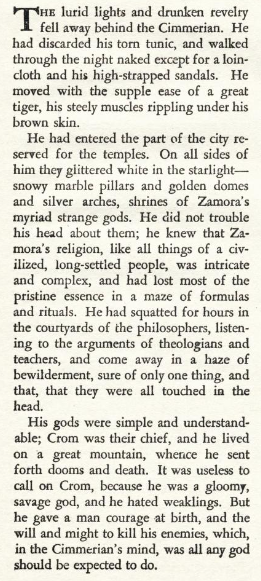
In particular, that last line summing up barbarian theology is basically a primer on both Howard’s view of the world as well as sword and sorcery as a genre – it’s all about a character alone and armed only with their courage and willpower taking on the world!
Conan (or, rather, the Cimmerian, because he hasn’t YET been named in this story) arrives at the Tower of the Elephant, a silvery spire with glassy outer walls and rimmed with gems that dominates the Zamoran skyline. It’s from here that Yara the Priest dwells and performs his strange magical rites.

Just fantastic evil magic stuff, really hammering home how this weird and mysterious force is quintessentially and elementally is opposed to the clean and natural strength of a barbarian. It’s also fun to see the inexplicableness of the tower AND gem’s names…they’re just named after Elephants, for some reason, and no one knows or remembers why. While Conan is musing on all this, he suddenly hears a noise from beyond the outer – the sound of someone tromping by. A guard, Conan thinks, but instead of hearing him come by again on his patrol, all is silent within.
Succumbing to his curiosity (and avarice), Conan clambers easily over the wall and drops down into the first of the inner rings surrounding the Tower. This one is wide and mostly open, with only some shrubberies near the far inner wall. Gliding pantherishly, Conan makes his way towards that inner wall, when he stumbles across the dead body of solider who has been strangled from behind. Somewhat unnerved by the uncanniness of the murder, Conan continues forward cautiously, his sword drawn and his senses alert. He spies a strange bulk near the wall, a shadowy figure who, somehow (and perhaps for the only time in any of these stories) actually hears Conan’s stealthy approach. The shape whirls around, resolving itself into a big-bellied but strangely lithe man!

There, finally, is Conan’s name. And we’re introduced to one of the first in a long-line of important and entertaining side characters in a Conan story. In this one its Taurus of Nemedia, the Prince of Thieves, but it could just as well be Balthus from “Beyond the Black River” or “Murilo” from “Rogues in the House.” Actually, it’s kind of interesting, but the very best Conan stories generally have a strong secondary character; Conan doesn’t have a lot of interiority, honestly, so it’s useful to have another POV that lets the reader see both Conan and how he fits into the world at the same time. Also, mechanically, it’s handy to have someone who can throw out exposition or explanations, which Taurus of Nemedia does here.
He quickly explains that Yara’s defenses rely on what lies beyond the inner wall, in the second garden. The human guards, like the man he killed, all hunker down for the night behind sealed doors in the lower chambers of the tower, leaving the garden to be defended by deadly, nonhuman sentinels. It’s these that baffled Taurus for so long, but he’s figured out some kind of scheme or plan for taking care of them. Once they’re neutralized, they’ll climb the tower, enter through the roof, murder Yara and take his Gem. Easy peasy!
Conan and his new best friend hop the wall and land in a lush inner garden. Conan prepares to stride forward, but Taurus, tense and on edge, pushes him back and tells him that, as he values his life, he must stay behind him. They wait; everything is silent at first, and then there’s movement in the bushes and among the trees, and terrible blazing eyes suddenly glare out at them from the foliage!

It turns out Taurus had a tube full of black lotus powder, a horrifically toxic substance that kills with the merest whiff. As an aside, Howard’s reliance on lotuses in these stories is really one of my favorite things. The black lotus shows up a lot, as does a white and (I think) a yellow lotus, all with strange and mysterious powers and properties. It’s a lot of fun, and puts Howard in a lineage with Homer and the Odyssey, as far as strange botanicals go.
Conan gets to display his prowess by killing one more lion with his sword, and then he and Taurus get to the tower itself, a metallic mass with smooth, glassy sides, seemingly unclimbable. But the wily Prince of Thieves has a solution to this problem, too!

Sometimes it seems like sword and sorcery is as much a genre about climbing as anything else – it’s such a common way to demonstrate the hero’s prowess, strength, courage, tenacity, AND their connection to wild landscapes and untamed nature. Of course a Cimmerian can climb like a cat, they live in a rocky, hilly landscape of towering precipices and foreboding cliffs! Taurus and Conan get to the tower, and that’s when Taurus gets a little tricksy. He tells Conan to go to the edge of the tower and check to see if the guards are alert. Conan is no dummy and thinks its an odd request, but he complies, and while he does Taurus slips in through the door, leaving his buddy behind. I guess he’s decided that he doesn’t want to share the spoils with Conan, but it doesn’t work out so well for our Nemedian Prince of Thieves:
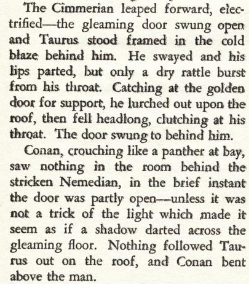
With a gurgle and a dumb look on his face, poor ol’ Taurus dies, apparently without even knowing what it was that had killed him! Examining his late compatriot’s body, Conan discovers a wound on the base of Taurus’s neck, like three nails that had been driven in and then pulled out. Already the edges of these marks are turning black, and there’s a faint smell of putrefaction. Cautiously Conan prods the door open, and inside the chamber he sees a bunch of fainting couches and several chests full of glittering gems. Already he’s found more wealth than he could’ve imagined existed in all the world! But, while he’s contemplating it, the guardian of the chamber attacks!

It’s a good ol’ fashioned giant spider fight, an encounter appropriate for one level 3-5 barbarian! Again, a little cliched now, but remember, Howard was writing this stuff in 1933! Give him a break! Besides, it’s a fun fight – the spider is super nimble, and it’s fun to think of it swinging through the chamber, trying sink its venomous fangs into Conan. When that doesn’t work, the spider then starts darting all around, roping off the chamber with thick cords of rough, sticky webbing that threatens to trap Conan. Finally, unable to come to grips with the monster using his sword, Conan lifts a huge chest full of gems and splatters the big crawlie with it. It’s neat!
Conan is nothing if not dogged, and despite the fact that he’s twice now encountered a king’s ransom in gems just lying around, he’s committed to finding the Heart of the Elephant. After all, if Yara was willing to just leave chests of gems sitting around in his rumpus room, imagine what the Heart must be like! So on he goes, venturing through the door and deeper into the silent, uncanny tower. Eventually he finds a huge ivory door with strange markings on it. He enters, and sees something truly strange:
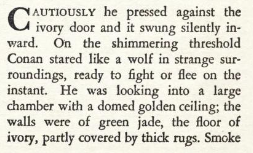

An elephant headed horror sits enthroned in this strange chamber, and its no mere idol…it’s a living thing! Conan is horrified, struck dumb and seemingly paralyzed by what can only be an elder demon of the old world. But then, Conan notices that the great amber eyes stare out blankly, and the trunk of the thing grope forward…the monster on the throne is blind. And then, it speaks with an unearthly voice!

It’s both a surprising reveal and an honestly moving bit of writing; Conan’s realization that this thing which he had been so horrified at has been made to suffer, has in fact been tortured, moves him to both deep pity and profound shame.
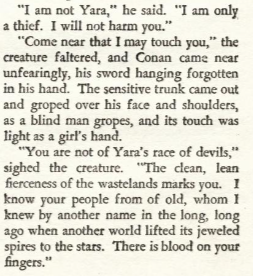
Possessed of senses beyond humankind, the elephant-heading thing senses that Conan has killed this evening, up to and including the man in the tavern. And it also knows that a man lies died above at the top of the tower. These two deaths seem to have some occult significance for the thing, who begins to share its story with Conan, explaining that he and others like him had come from a weird green planet called Yag, rebels against their king there. Seeking refuge on earth their wings withered and so they came to live in the primordial world, warring against the prehuman monsters that dwelt there. They conquered, and watched humans rise from ape-dom to the kingdoms of Valusia and Atlantis, and they saw the cataclysm that swallowed those ancient lands and gave rise to the world of Conan and his people. One by one his people died throughout the long ages, until only he, Yag-Kosha, was left, worshipped as a god far in the east. But it was there that Yara found him and, feigned to be his acolyte, learned magic from Yag-Kosha. But, like all evil wizards, he wanted to know Dark Sorcery, which Yag-Kosha would not teach him. Using forbidden magic he’d learned in Stygia, Yara was able to trap and enslave Yag-Kosha, forcing him to use his magic to fulfill Yara’s every whim.

Conan takes up the gem, a great clear crimson crystal, the Heart of the Elephant. Yag-Kosha has a plan, and Conan is now a part of it.

It’s really good, and Yag-Kosha’s story and in particular his speech here is some great, eldritch stuff, truly weird and unearthly and hinting at much stranger stuff. It also nicely demonstrates the importance of weirdness in sword-and-sorcery (which is, of course, a subgenre of the larger genre of weird fiction). Rather than just pure supernaturalism, Yag-Kosha is, basically, a Lovecraftian alien-god, made of different stuff and possessing alien powers, sure, but in a way that’s consistent with a vision of a material (if strange and magical) universe.
Conan complies with Yag-Kosha’s wishes, cutting out its heart and then squeezing the blood onto the gem, where it gets soaked up, like a sponge. As he’s leaving, he senses that there’s something strange and marvelous going on with Yag-Kosha’s remains, but he averts his eyes, not sure whether he could safely witness it.

The gem has become murky and pulses with a strange power that seems to draw and trap Yara’s attention. The wizard stoops over and grips the gem, staring into its depths, and Conan realizes with a start that the wizard is shrinking. Soon he is no larger than a child, and its only when he’s baby-sized and standing on the table that the evil sorcerer seems to realize his danger. He drops the gem and tries to flee, but some kind of weird magnetism has trapped him; he can only run in ever tightening circles around the jewel, drawing closer and closer with each circuit. Eventually, big as a mouse, Yara ends up atop the gem, and then his final doom comes upon him:

Conan turns and hauls ass out of the tower, running downward through the lower halls, seeing the guard room full of suddenly and mysteriously killed guards. Yag-Kosha had said the way would be made clear for him, and if there’s one thing weird elephant-headed space gods are, it’s honest. Conan finds it all to be a bit too much though, and decides to get out of Dodge:
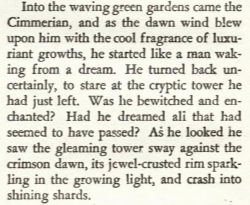
And, with that crashing apocalyptic collapse, so ends “The Tower of the Elephant.”
It’s really almost the perfect sword-and-sorcery tale, inventive and thrilling and action-packed, but also moody and contemplative and a little sad. There’s real cosmic sorrow in Yag-Kosha, and Conan’s sense of humankind’s collective shame for his imprisonment is particularly poignant; it’s probably the most introspective Conan ever gets, unfortunately. Don’t get me wrong, there’re some truly great Conan stories yet to come, full of great ideas and inventive plots and fun characters, but I really think that this is my favorite of the series. It’s so effortlessly fun (and weird!), and it really lays out what makes for great sword-and-sorcery. It’s been a lot of fun re-reading it and thinking about it, and I hope ya’ll have enjoyed both it AND my ridiculously wordy musings about it too. Anyway, stay tuned, we’re only half-way through Sword and Sorcery month, and I’m thinkin’ I’ll do a fun one for the solstice next week. See ya’ll then!

